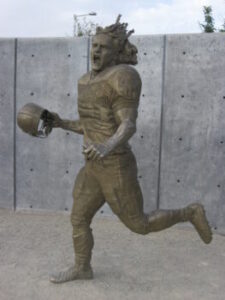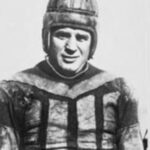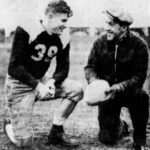In the long, long history of the Arizona Cardinals, it is interesting to note that in over 120 years, only five team uniform numbers have been retired.
But these guys deserved it…
In this episode of “When Football Was Football” we’ll look back at the accomplishments of those individuals, while focusing on one member of that illustrious club who seems to have been…a bit forgotten.
The retired numbers are those of Marshall Goldberg, who wore #99, J.V. Cain (#88), Stan Maudlin (#77), Larry Wilson (#8) and Pat Tillman (#40). Only Wilson is a member of the Pro Football Hall of Fame, although Goldberg was once a finalist in the senior voting. However, each of these players has made unique contributions to pro football’s oldest team.
Marshall Goldberg was an icon, a true team leader who witnessed the highs and the lows of the Cards’ resurgence in the 1940s. He was a solid, two-way player who unselfishly concentrated on defense to help the Cards catapult to the championship in 1947. More recently, that unselfish nature was evident again as his family allowed newcomer J.J. Watt to wear and “unretire” Goldberg’s famed #99 jersey when Watt joined the Cardinals in 2021.
After an All-American career as a halfback and fullback at Pittsburgh, Goldberg was drafted by the Cardinals in 1939. Goldberg was named an All-Pro four times during his tenure with the Cardinals from 1939-1948, although he served in the military from 1943-1945. Goldberg was part of the “Dream Backfield” that swept the Cardinals to the 1947 NFL championship, with Goldberg switching primarily to defense during the latter part of the season.
Goldberg Led the NFL In Five DIfferent Categories
His coach, Jimmy Conzelman, once said: “Goldberg might well have been the first defensive specialist in pro football. And he was a great one. He was one of the few backs who consistently did well against Don Hutson. And he was a fine returner of punts.
Marshall Goldberg may be one of the most underrated players ever to play in the pros. At one time in one season, he led the league in five different departments. Imagine what a player with those statistics could command in today’s market!”
You've Got To Play With Injuries
Larry Wilson entered the Pro Football Hall of Fame in 1978 after a stellar 13-year career with the Cardinals in which he was probably the most feared free safety in the NFL. Cardinals players of any generation would have welcomed a “tough as nails” type of teammate such as Wilson, who once intercepted a pass and returned it for a touchdown with two broken wrists!
Wilson was named to the Pro Bowl eight times and was also a member of the NFL’s 75th and 100th Anniversary Teams selected in 1994 and 2019 respectively. Overall, Wilson picked off 52 passes during his career with the Cardinals, but was widely respected for playing while injured. Columnist Bill Lyon once wrote: “In a game that is storied for its ferocity, its violence and its high threshold of pain, Larry Wilson is without peer in terms of both talent and courage.”
Ironically, Wilson cracked a rib during his final professional game in 1972, but still managed to stay on the field. Wilson later said: “In this business, you’ve got to play with injuries.” Immediately after that game, the Cardinals retired his #8 jersey.
Cain Was Absolutely Amazing
James Victor “J.V.” Cain was a sparkling prospect out of Colorado when the Cardinals drafted the talented tight end in the first round of the 1974 draft. Within a couple of years, Cain moved into a starting role with a bright NFL future in front of him.
He later told the St. Louis Post-Dispatch: “When I first started pro ball, it seemed I was infatuated with that fact. I had so much to learn. I had no experience. But I’ve had to go through a learning stage each time I moved up in football. I‘m used to taking my time in learning.”
And learn he did. By 1977, he had established himself as a solid blocker and receiver, pulling down 76 career passes for 1,014 yards and nine touchdowns for the Cardinals. Then, unfortunately, he tore his Achilles tendon and missed the entire 1978 season. After completing his rehab, Cain was ready for bigger and better things in 1979 as the starting tight end for the Cardinals.
Before each practice, he ran several 100-yard wind sprints before the team workout began, impressing head coach Bud Wilkinson: “Cain was absolutely amazing, the way he conditioned himself,” praised Wilkinson.
Then, during a routine non-contact passing drill during pre-season practice at Lindenwood College on July 22, 1979, Cain collapsed on the field and was later pronounced dead. Columnist Tom Barnidge wrote a day later: “More than a tight end, he will be remembered as a fine person. One who was called too soon. Without warning. Without explanation. And some of his words will hang heavy in his absence.
‘I don’t want people to forget about me,’ he said from last year’s sideline [while recovering from his injury], ‘and maybe say a prayer for me.’ No one will forget. There’s far too much to remember.” J.V. Cain (#88) passed away on his 28th birthday.

Tillman Turned Down A Multi-Million Dollar Contract
Many will recall the more recent sacrifice of Patrick Daniel Tillman, Jr. who quietly gave up a lucrative professional football career with the Cardinals in May of 2002 to enlist in the U.S. Army. The popular safety, who wore #40, was a fixture with the Cardinals after being drafted in the seventh round of the 1998 NFL draft.
As gifted in the classroom as he was on the gridiron, Tillman graduated from Arizona State in just 3 ½ years with a lofty 3.85 GPA in marketing. He was also the MVP at linebacker for ASU and the PAC-10’s Defensive Player of the Year in 1997. At just 5-11 and 200 pounds, Tillman was initially considered to being too small for the rigors of the NFL.
However, he quickly made the transition to safety with the Cardinals and ended up starting ten games during his 1998 rookie season. By 2000, he started all 16 games and was in on 155 tackles, 118 of those being solo stops. In 2001, Tillman started all 12 games in which he played and was more important than ever to the Cardinals’ defense.
Then, in the spring of 2002, Tillman turned down a multi-million-dollar contract offer from the Cardinals and enlisted in the Army. After serving in both Iraq and Afghanistan, Pat Tillman lost his life in service to his country on April 22, 2004 in Afghanistan.
One Of The Best Freshman Linemen In The NFL
The final notable of the Cardinals’ retired jerseys was Stan Mauldin, a burly tackle out of Texas who toiled in the trenches from 1946-48. Mauldin was also an integral part of the Cards’ front line during the NFL championship season of 1947, starting all twelve games and being named All-Pro by both UPI and Pro Football Illustrated.
A graduate of the University of Texas in 1943, Mauldin flew 35 missions in Europe during World War II before signing with the Cardinals on February 22, 1946. At 6-2 and 225 pounds, Mauldin was a big, mobile tackle who was effective from both sides of the line.
He injured his knee in a 34-14 win over the Detroit Lions in the second game of the season on September 30, 1946, but managed to appear in six games with four starts after resting the leg. The Austin-American said of Mauldin: “Mauldin made his debut in professional football with the Chicago Cardinals, and he was called one of the best freshman linemen in the play-for-pay game.”
By 1947, both the Cardinals—and Mauldin—were ready. The team rolled through the rest of the league to capture the 1947 NFL title and Mauldin was immoveable from his tackle slot, earning every bit of his All-Pro recognition. The Cardinals were big favorites to reclaim the NFL crown in 1948 and finished the regular season with an 11-1 mark, the best in team history, before losing the championship game 7-0 in a blizzard to the Eagles.
But the team’s biggest loss that season occurred in the season opener, also against Philadelphia. Shortly after the game, Stan Mauldin suffered a massive heart attack in the dressing room and passed away at the age of 27. The Associated Press reported on his last moments: “As he undressed, he complained of a headache. After he showered, he commented: ‘That was some game we won, fellows.’ Then he collapsed.”
Mauldin Is Irreplaceable
Needless to say, the NFL world was shocked by this sudden loss. Cardinals’ coach Jimmy Conzelman said: “Mauldin is irreplaceable both as a great football player and as a man.” Perhaps Philadelphia Eagles coach Greasy Neal said it best when speaking of Mauldin: “The National Football League has just lost its greatest tackle.”
What would become of Stan Mauldin if he had been allowed to complete his NFL career? It is not unreasonable that we might look at him today as a respected member of the Pro Football Hall of Fame based on both his auspicious start and his incredible potential. We’ll never know, but at the same time, we must never forget.
And let us not forget the other members of this elite circle in addition to Stan Mauldin: Marshall Goldberg, Larry Wilson, J.V. Cain, and Pat Tillman—the only five men who have received the honor of having their numbers retired in the history of the NFL’s oldest team.
Thank you for joining us on this episode of “When Football Was Football” on the Sports History Network and please stop by next time for another look at a forgotten aspect of early pro football.
Author and Host - Joe Ziemba
Joe Ziemba is the host of this show, and he is an author of early football history in the city of Chicago. Here, you can learn more about Joe and When Football Was Football, including all of the episodes of the podcast.
Please Note – As an Amazon Associate I earn from qualifying purchases
Resources
More From When Football Was Football
Ugly Passers, Brick Walls, and Feisty Cardinals
Since the Arizona Cardinals are the NFL’s oldest team, with...
Read MoreThe NFL’s Forgotten Gold Medalist!
As usual during the staging of the Summer Olympics, numerous...
Read MorePaddy Driscoll’s Almost Perfect Season
Back at the beginning of the National Football League in...
Read More120,000 Fans Witness High School Football Game in 1937!!!
Let’s set the stage… It was a warm November afternoon...
Read More



